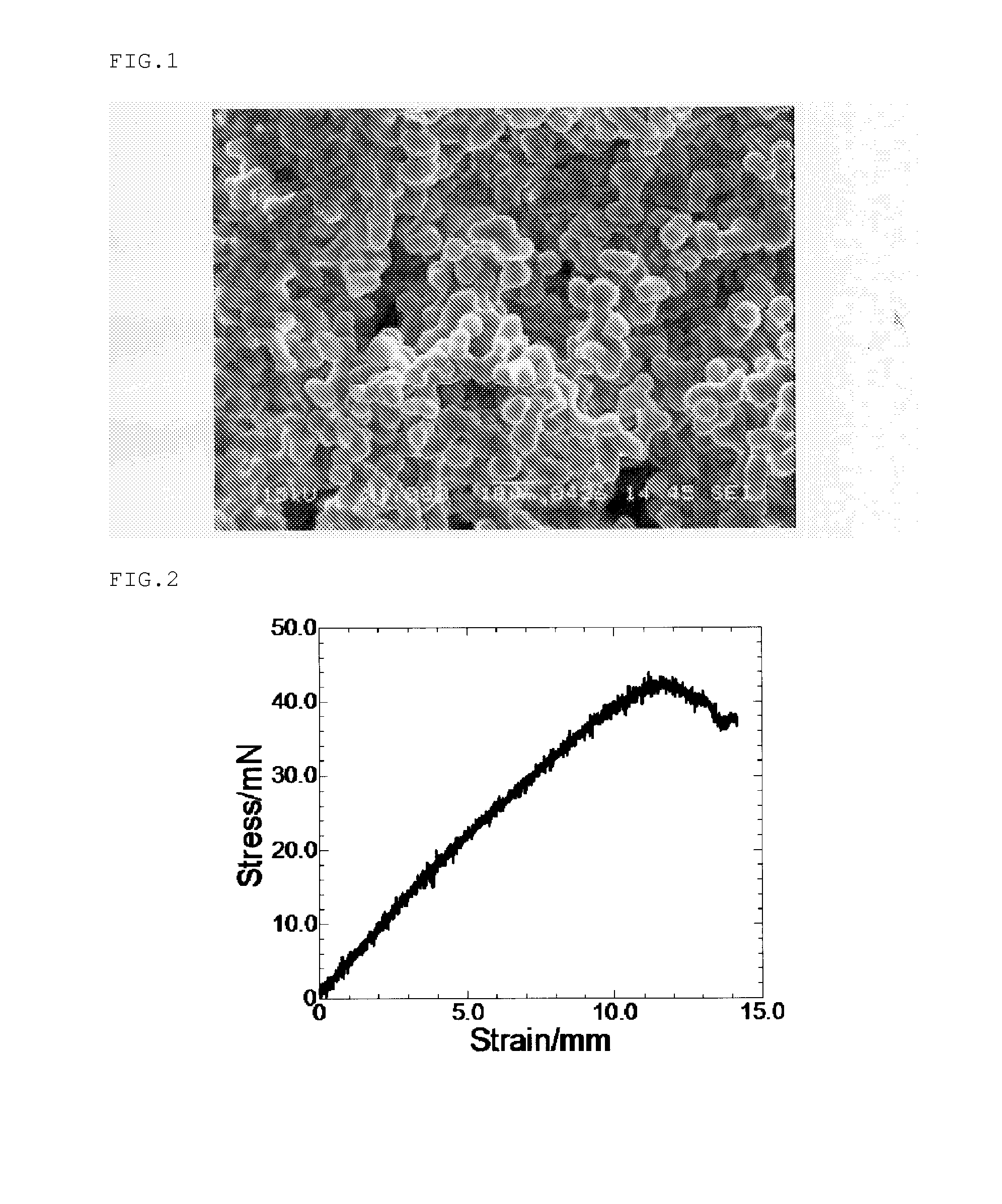Monolithic silicone and method of separation, purification and concentration therewith
a monolithic silicone and polymer technology, applied in the field of monolithic silicone, can solve the problems of inconvenient use of separation, purification, filler needs large energy for desorption, and may cause dehydration of 2-methylisoborneol, and achieve high porosity, effective use of flexibility, and high flexibility
- Summary
- Abstract
- Description
- Claims
- Application Information
AI Technical Summary
Benefits of technology
Problems solved by technology
Method used
Image
Examples
example 1
[0127]In a glass vessel, 0.8 g of a surface active agent of n-hexadecyltrimethylammonium chloride necessary for phase separation and 5.0 g of urea were mixed with 15 mL of a 5 mM acetic acid aqueous solution, and 3 mL of methyltrimethoxysilane and 2 mL of dimethyldimethoxysilane were added to the thus obtained mixed solution. After stirring the solution with a stirrer for 30 minutes, the solution was transferred to a sealed vessel and allowed to stand at 80° C. to be gelled. Thereafter, at the same temperature, the thus obtained gel was allowed to stand for 2 days to be aged under basic conditions derived from hydrolysis of urea. The thus obtained wet gel was immersed in a water / isopropyl alcohol (1:1) solution and then washed with isopropyl alcohol, so as to remove an unreacted reagent and the surface active agent. Ultimately, after the isopropyl alcohol used as a solvent was replaced with normal hexane, it was removed through evaporation drying under atmospheric or lower pressure,...
example 2
[0131]A present solid phase material obtained in the same manner as in Example 1 was used for analyzing an aquatic mold smell component (of 2-MIB) by the purge and trap method.
Experiment Conditions:
(1) Conditions for Extracting / Concentrating Mold Smell:
[0132]1. Concentration of sample water: 10 ppt
[0133]2. Extraction temperature for sample water: 60° C.
[0134]3. Flow rate of sample water: 2 mL / min.
[0135]4. Flow rate of purge gas: 80 mL / min.
[0136]5. Extraction time: 2.5 min.
[0137]6. Capturing agent: present solid phase material PDMS (50 mg)
[0138]7. Capturing temperature: 60° C.
(2) GCMS Measurement Conditions (in OPTIC TD Mode)
[0139]1. Temperature for heating capturing tube in introducing sample: 220° C. (5° C. / sec.) (retention time: 10 min.)
[0140]2. Analysis column flow rate: 1 mL / min.
[0141]3. Split: 10 mL / min.
[0142]4. GC oven temperature: 40° C. (12 min.)-20° C. / min.-250° C. (5 min.)
[0143]6. Capillary column: InertCap 5MS / Sil (0.25 mm I.D×30 m, df=0.25 μm)
[0144]8. SIM mode: 2-MIB (m / ...
example 3
[0145]A present solid phase material produced in the same manner as in Example 1 has flexibility, and an organic solvent included (retained) in the present solid phase material may be mechanically expressed. For example, a syringe may be used for expressing an organic solvent from a present solid phase material in the following manner (see FIG. 22).
[0146](1) A present solid phase material including an organic solvent is put in a syringe.
[0147](2) A plunger is inserted into the syringe.
[0148](3) The present solid phase material including the organic solvent is pressed by the plunger so as to express the organic solvent. Since analytes may be thus extracted by using an organic solvent merely in a volume corresponding to a spatial volume, there is no need to perform concentration process as in a conventional method, and the amount of organic solvent to be used is small.
[0149]A present solid phase material produced in the same manner as in Example 1 was used for analyzing a fragrance co...
PUM
| Property | Measurement | Unit |
|---|---|---|
| diameter | aaaaa | aaaaa |
| pore diameter | aaaaa | aaaaa |
| temperature | aaaaa | aaaaa |
Abstract
Description
Claims
Application Information
 Login to View More
Login to View More - R&D
- Intellectual Property
- Life Sciences
- Materials
- Tech Scout
- Unparalleled Data Quality
- Higher Quality Content
- 60% Fewer Hallucinations
Browse by: Latest US Patents, China's latest patents, Technical Efficacy Thesaurus, Application Domain, Technology Topic, Popular Technical Reports.
© 2025 PatSnap. All rights reserved.Legal|Privacy policy|Modern Slavery Act Transparency Statement|Sitemap|About US| Contact US: help@patsnap.com



